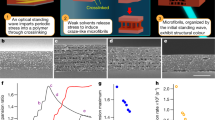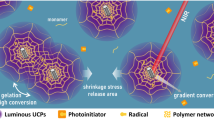Abstract
The absorption of light by a material generates heat through non-radiative energy dissipation and exothermic photochemical reactions1. In nanostructured materials, the heat generated through photothermal processes will be confined within the individual nanostructures when heat transfer to neighbouring nanostructures and the environment is slow. This leads to unprecedented photothermal effects that cannot be observed in bulk materials, especially when a strong, pulsed light source is used2,3. Here we demonstrate an enhanced photothermal phenomenon with conducting polymer nanofibres in which a camera flash causes instantaneous welding. Under flash irradiation, polyaniline nanofibres 'melt' to form a smooth and continuous film from an originally random network of nanofibres. This photothermal effect can be used to form asymmetric nanofibre films, to melt-blend polymer–polymer nanocomposites rapidly and to photo-pattern polymer nanofibre films.
This is a preview of subscription content, access via your institution
Access options
Subscribe to this journal
Receive 12 print issues and online access
$259.00 per year
only $21.58 per issue
Buy this article
- Purchase on Springer Link
- Instant access to full article PDF
Prices may be subject to local taxes which are calculated during checkout





Similar content being viewed by others
References
Rosencwaig, A. Photoacoustics and Photoacoustic Spectroscopy (Wiley, New York, 1990).
Ajayan, P. M., Ramanath, G., Terrones, M. & Ebbesen, T. W. Igniting nanotubes with a flash: Response. Science 297, 192–193 (2002).
Wang, N., Yao, B. D., Chan, Y. F. & Zhang, X. Y. Enhanced photothermal effect in Si nanowires. Nano Lett. 3, 475–477 (2003).
MacDiarmid, A. G. Polyaniline and polypyrrole: where are we headed? Synth. Met. 84, 27–34 (1997).
Huang, W. S., Humphrey, B. D. & MacDiarmid, A. G. Polyaniline, a novel conducting polymer. J. Chem. Soc. Faraday Trans. 82, 2385 (1986).
De Albuquerque, J. E., Melo, W. L. B. & Faria, R. M. Determination of physical parameters of conducting polymers by photothermal spectroscopies. Rev. Sci. Instrum. 74, 306–308 (2003).
De Albuquerque, J. E., Melo, W. L. B. & Faria, R. M. Photopyroelectric spectroscopy of polyaniline films. J. Polym. Sci. B 38, 1294–1300 (2000).
Toyoda, T. & Nakamura, H. Photoacoustic-spectroscopy of polyaniline films. Jpn J. Appl. Phys. 34, 2907–2910 (1995).
Huang, J. X. & Kaner, R. B. A general chemical route to polyaniline nanofibers. J. Am. Chem. Soc. 126, 851–855 (2004).
Huang, J. X., Virji, S., Weiller, B. H. & Kaner, R. B. Polyaniline nanofibers: facile synthesis and chemical sensors. J. Am. Chem. Soc. 125, 314–315 (2003).
Ding, L. L., Wang, X. W. & Gregory, R. V. Thermal properties of chemically synthesized polyaniline (EB) powder. Synth. Met. 104, 73–78 (1999).
Pandey, S. S., Gerard, M., Sharma, A. L. & Malhotra, B. D. Thermal analysis of chemically synthesized polyemeraldine base. J. Appl. Polym. Sci. 75, 149–155 (2000).
Wei, Y. & Hsueh, K. F. Thermal-analysis of chemically synthesized polyaniline and effects of thermal aging on conductivity. J. Polym. Sci. A 27, 4351–4363 (1989).
Mathew, R., Mattes, B. R. & Espe, M. P. A solid state NMR characterization of cross-linked polyaniline powder. Synth. Met. 131, 141–147 (2002).
Huang, S. C., Ball, I. J. & Kaner, R. B. Polyaniline membranes for pervaporation of carboxylic acids and water. Macromolecules 31, 5456–5464 (1998).
Nunes, S. P. & Peinemann, K. -V. Membrane Technology in the Chemical Industry (Wiley-VCH, Weinheim, 2001).
Sansinena, J. M., Gao, J. B. & Wang, H. L. High-performance, monolithic polyaniline electrochemical actuators. Adv. Funct. Mater. 13, 703–709 (2003).
Wang, H. L., Gao, J. B., Sansinena, J. M. & McCarthy, P. Fabrication and characterization of polyaniline monolithic actuators based on a novel configuration: integrally skinned asymmetric membrane. Chem. Mater. 14, 2546–2552 (2002).
Gao, J. B., Sansinena, J. M. & Wang, H. L. Tunable polyaniline chemical actuators. Chem. Mater. 15, 2411–2418 (2003).
Gao, J. B., Sansinena, J. M. & Wang, H. L. Chemical vapor driven polyaniline sensor/actuators. Synth. Met. 135, 809–810 (2003).
Rodrigues, P. C., de Souza, G. P., Neto, J. D. D. & Akcelrud, L. Thermal treatment and dynamic mechanical thermal properties of polyaniline. Polymer 43, 5493–5499 (2002).
Kieffel, Y., Travers, J. P., Ermolieff, A. & Rouchon, D. Thermal aging of undoped polyaniline: effect of chemical degradation on electrical properties. J. Appl. Polym. Sci. 86, 395–404 (2002).
Tan, H. H., Neoh, K. G., Liu, F. T., Kocherginsky, N. & Kang, E. T. Crosslinking and its effects on polyaniline films. J. Appl. Polym. Sci. 80, 1–9 (2001).
Liu, G. & Freund, M. S. New approach for the controlled cross-linking of polyaniline: synthesis and characterization. Macromolecules 30, 5660–5665 (1997).
Conklin, J. A., Huang, S. C., Huang, S. M., Wen, T. L. & Kaner, R. B. Thermal properties of polyaniline and poly(aniline-co-o-ethylaniline). Macromolecules 28, 6522–6527 (1995).
Smits, J., Wincheski, B., Namkung, M., Crooks, R. & Louie, R. Response of Fe powder, purified and as-produced HiPco single-walled carbon nanotubes to flash exposure. Mater. Sci. Eng. A 358, 384–389 (2003).
Braidy, N., Botton, G. A. & Adronov, A. Oxidation of Fe nanoparticles embedded in single-walled carbon nanotubes by exposure to a bright flash of white light. Nano Lett. 2, 1277–1280 (2002).
Acknowledgements
We thank C.-W. Chu for help with FTIR measurements. We acknowledge the financial and program support of the Microelectronics Advanced Research Corporation (MARCO) and its Focus Center on Function Engineered NanoArchitectonics (FENA).
Author information
Authors and Affiliations
Corresponding author
Ethics declarations
Competing interests
The authors declare no competing financial interests.
Supplementary information
Rights and permissions
About this article
Cite this article
Huang, J., Kaner, R. Flash welding of conducting polymer nanofibres. Nature Mater 3, 783–786 (2004). https://doi.org/10.1038/nmat1242
Received:
Accepted:
Published:
Issue Date:
DOI: https://doi.org/10.1038/nmat1242
This article is cited by
-
Polymer-based nanocomposites as defence material
Bulletin of Materials Science (2023)
-
Intelligent non-colorimetric indicators for the perishable supply chain by non-wovens with photo-programmed thermal response
Nature Communications (2020)
-
Kinetic preparation and antibacterial activity of nanocrystalline poly(2-aminothiophenol)
Polymer Bulletin (2019)
-
Ceramic nanowelding
Nature Communications (2018)



